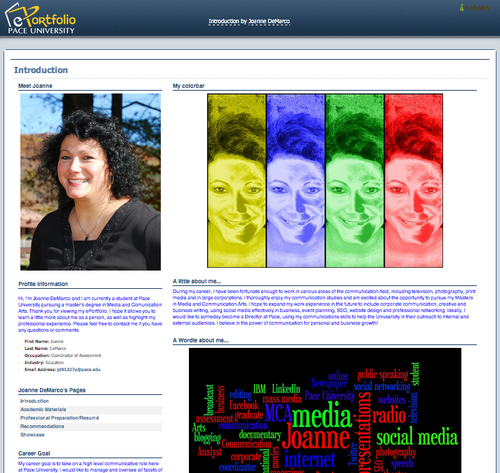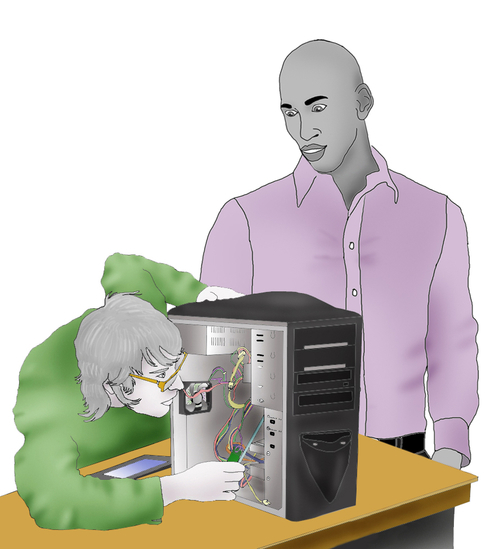Mahara can be used in lots of different ways towards lots of different ends. Here are just a few different examples:
- A recruitment agency might use Mahara to forge links between jobseekers and employers, employers with other employers, and jobseekers with other jobseekers.
- A university or college might use Mahara as a reflective learning platform for all of their students, following all different types of learning programs. You can refer to the following example of a Mahara ePortfolio, created by Joanne DeMarco at Pace University:

- A students' union might use Mahara as a vehicle for members of its clubs and societies to share their knowledge and their passions. For example, football, canoeing, the darts team, political groups, and so on.
- A school teacher might use Mahara to get his/her small group of students to work together on a curriculum-related topic.
- A professional body may wish to set up Mahara for communicating with members and for the continuous professional development of its members.
- A private training provider might use Mahara as a way for learners to collate and submit their work for assessment as part of their qualification.
- A group of friends may wish to use Mahara to communicate and collaborate in a much more controlled way than Facebook.
- A group of professionals from different organizations/locations may wish to work together on sharing best practice ideas, and to support each other through a variety of challenging situations, for example, a group of social workers. See the following screenshot of a Mahara page example, Web 2.0 Tools & Video Gaming in Physical Therapy:

- A large organization or corporation could use Mahara for their informal knowledge management processes, encouraging people in similar roles in different branches to work together in online communities of practice.
The list goes on...
The example screenshots in the previous section can be found by visiting http://groups.diigo.com/group/everything-mahara and filtering by the mahara_portfolio_example tag. There are plenty of other examples to look at there.
In this book, we want you to look at the many ways in which you can use Mahara to fit your own specific situation. To help you to do this, we will often be illustrating the different things that you can do with Mahara by using any of the following four imaginary case studies.
Punam is a teacher at Pennytown Primary and she is taking her nine-year old students through a project on the Tudors. She is working with an institutional-themed Mahara, which is set up on "Schools Online", a large, county-wide Mahara implementation for school teachers who are working in an English county called Rurishire:

Punam will be helping her students to work as a class group in order to gather files and discuss their learning. She doesn't just want them to upload a whole load of files, she wants them to organize files and data in a meaningful way, just like a paper-based project. This will mean that she wants her students to create pages in smaller working groups for their class project. She likes the idea of smaller working groups as this will allow her students to start working collaboratively. She likes the fact that Mahara facilitates this by allowing you to set up different groups and to create a collaboratively created group page.
Some of her students' parents have come up to her and expressed concerns about online safety; one of their children has been the victim of cyber-bullying. However, Punam is satisfied that Mahara addresses this concern as, unlike Facebook, the only people that have access to the site are those that have been given permission by the school. The local education authority has set a policy that any adult that has access to this site must have passed a police check. If there are any concerns regarding cyber-bullying of the children, she can request that the administrator accesses all the pages and forum posts so that she can find out who was responsible, and request suspension of the user if appropriate. She can happily reassure the parents that this is a walled garden site where their children are safe. There is even a facility for the learners to report objectionable material to the administrators, should they stumble upon any.
Finally, Punam has heard that there are a few Google Android mobile phone applications and an iPhone application available for Mahara. Now her students will be able to capture video and images from school field trips and upload them instantly to their personal portfolios saving the time taken in putting them onto a USB stick and uploading them to the Internet.
Janet is a learning technologist who holds overarching responsibility for PI Inc.'s International Corporate University. Each country, indeed, each and every branch that she represents, has its own local learning agenda:

As a learning technologist she wants to encourage informal, personalized, and reflective learning. She knows that spending time in encouraging reflection and Continuous Professional Development (CPD) helps to:
- Develop staff skills - creating a better workforce.
- Increase staff morale.
- Encourage the development of professionalism.
- Increase staff retention as staff feel more valued.
- Encourage innovation, which will help give PI Inc. an edge over their competitors.
- Give out a strong corporate message about investment in people.
However, Janet's main focus is on implementing Mahara to facilitate informal international knowledge transfer processes. She wants to spend some time setting up different types of groups. She can see the benefit of setting up groups to work on a variety of research projects being carried out throughout the organization. She is hopeful that the group members are going to make use of Mahara's journaling features to keep everyone up-to-date with their particular projects.
There are currently three pilot studies being carried out in England, Peru, and Spain for a new cancer drug, and she wants these three research groups to collaborate and discuss early findings. She also wants to set up some international groups of practice and collaborate in the hope that this will lead to some useful organizational innovations. Finally, she wants to set up some groups that a few selected individuals can access from outside the company to bring in some fresh ideas and perspectives, whilst also contributing to the wider pharmaceutical community.
PI Inc. is, therefore, running their own large international Mahara implementation with a range of their own institutions. Janet's people will be sharing their knowledge. PI Inc. will be capturing their knowledge before they leave. And, by engaging in this process, Janet's staff members will be creating new and innovative knowledge, which PI Inc. can make use of as they move into the future.
Tip
What is a Mahara institution?
An institution in Mahara is a subdivision of the site, which can have its own theme, users, and administrators. There is more on Mahara institutions in Chapter 6, Course Groups and Other Roles in Mahara.
Neil trains and assesses learners who are taking national vocational qualifications with a private training provider called Training for Work. He is helping sixteen to nineteen-year olds to gain their vocational qualifications in Electrical Engineering. Although Training for Work only has about fifteen people on its staff, they have installed their own organizational Mahara because they like to have control over their own site:

Neil is keen to use the Résumé Builder feature of Mahara. He has a number of links with local businesses for work placements, and he prides himself on the high percentage of learners who go on to full time positions. He knows if he can get all his learners to input all of their information into the résumé builder and create an online résumé, not only will this make matching his learners to work placements easier, but also really impress prospective employers.
Neil knows that at the moment his learners' files and evidences are stored all over the place in a variety of locations. Some of the homework is currently handed in as paper assignments. Some assessors have video and audio evidences stored in their video cameras, smart phones, or on their laptops, with handwritten notes. Some other parts of the work that his learners have done are stored on the Training for Work desktops up in the computer room. His inbox is always full of e-mails from students sending him files with huge attachments to check. New students want to submit evidence in an ePortfolio as they did at Uppertown Secondary School. Finally, when he makes on-site visits he finds that his students have often forgotten to bring their evidence with them, leading to yet another wasted trip! Assessing has become a complete nightmare! He spends more time actually trying to find the evidence than he does teaching and supporting his students.
Neil says he will make extensive use of Mahara's artefacts feature. This will allow him to get the students to organize their digital stuff (artefacts) into one central location where they can then share them with him, verifiers, and also other students easily, using pages. As it will be accessible anywhere, anytime there is Internet access, students can no longer forget or lose their work. He has also been set up as a Mahara staff member (more on this in Chapter 6, Course Groups and Other Roles in Mahara), which will allow him to assign his learners to a controlled group — it is into this that the learners will submit pages evidencing their learning, enabling their formal assessment. Neil will, of course, set up a template page for learners to copy and build their evidence upon. The learners will not be able to edit their submitted pages again until Neil releases them with his feedback. Neil needs this sort of control because his accrediting body and external verifiers require him to have it.
Neil is also excited by the fact that his learners are able to make plans.
Neil can't wait to start using Mahara! It will make his life so much easier. He can give online coaching as and when needed, there will be no more forgotten files and wasted trips, and most importantly his students will learn more — and learn to reflect more — as this will help them not only to gain their all important qualifications, but also to become more valuable employees.
Silverworks University has recently decided that they would like to offer an online ePortfolio building system for their fine arts students alongside the traditional artist's portfolio. They can see the benefit of having a single location where students can access all their videos, images, and inspirations from anywhere, as opposed to the traditional carry-folder approach. The system they have chosen to work with is Mahara.
Christophe is a tutor of fine arts at the Silverworks University and is responsible for mentoring 10 students.

He is the person in the department with the most interest in technology and has excitedly offered himself and his tutor group as the test bed for the new system. He's really interested in the potential of Mahara to allow his students to quickly add their work, sketches, and developments to their online portfolios. No longer will work that is being developed at the students' home be inaccessible for tutorials.
He likes that with Mahara, students are able to control exactly who can see their work. In the run up to their degree show, Christophe is encouraging his students to use Mahara pages to show off their portfolios to the web. He really likes the collections feature, which enables his students to link sections of their portfolios together into a coherent story.
He has even started to look into a few extensions that are available for Mahara, which will allow his tutor group to pull a wide range of content from external websites and to integrate with social media.
Not only that, but Christophe is himself a graphic artist. He will be using Mahara for his own personal use. He is keen on the journal feature, and has decided to keep a log of each day that he spends on a new comic. He is glad that he will no longer have to keep track of all those scraps of paper with ideas scribbled down in cafes — he can add them to his Mahara portfolio!
